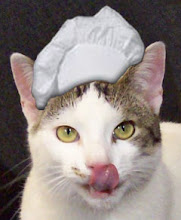
Nothing beats freshly made homemade pasta, and it is actually quite simple to make!! Of course if you have an electric mixer and an Imperial type pasta cutter it makes the process much easier but even without them it is not a mission impossible, until two years ago when we bought them, I used to do it all by hands quite regularly, and it's really worth the effort, also you can make enough for 2-3 dinners in one go as it keeps in the fridge for several days!!
1 egg to every 100g of flour
Have some water in a little cup/jug handy
1. Kneading
-with an electric mixer
Put the flour in, then make a slight dent and crack the eggs into the dent.
Turn on the mixer, first on slower, then turn it up gradually. If the dough is too dry, add a little water, a few drops at a time. The dough must remain full of body, and shouldn't turn sticky or runny. When the consistency of the dough stabilises turn the mixer up to a vigorous cycle near full speed. Let it knead for about 5-10 minutes, checking intermittently, until the dough is smooth, elastic and very compact.
-by hand
Before you start, keep extra flour handy, make sure your hands are dry and covered with flour.
Pile the flour on a clean, smooth, flat work surface, thoroughly dusted with flour. Make a well in the centre. Beat the eggs, and carefully pour the mixture into the well. Carefully let the top edges of the flour into the eggs, then smoothing up the flour from the outer sides towards the centre to guide into the eggs, let it slowly incorporate into the pile of flour. If the egg spew out don't panic, swiftly push the "lava" into the flour and continue to work. Once the eggs are roughly amalgamated into the flour, start kneading vigorously, thoroughly from every angle, utilising your body weight. If the dough is too dry and crumbly, add just a few drops of water (and no more) at a time, to make the dough smooth enough to work with but never let it become sticky or runny. Sprinkle generous amount of extra flour on the work surface as needed. Continue to knead in the same manner for at least 20 minutes, until the dough is elastic, smooth and compact.
If you are rolling out the dough by hand,
Cover the dough with a plastic film, and let it rest for about an hour. This resting will "tame" the elasticity and make flattening process easier.
2. Flattening
Again prepare a clean, smooth, flat surface to work, strewn with flour and smear more flour onto your hand as well, and more flour ready nearby.
-with a pasta cutter
Secure the pasta cutter on the work surface.
Separate the dough into smaller pieces in order to fit them through the cutter easily and evenly. First Roll each pieces out on the thickest setting.
Narrow down a couple of notches and repass each pieces. If it gets too long, cut in half.
Continue until each piece is about 1,5mm thick sheets for lasagne or filled pasta (ravioli, tortellini etc.), 1mm for tagliatelle, trenette etc.
-by hand
Separate the dough in a few pieces. With a rolling pin flatten out each piece evenly, gradually working into thin sheets, 1,5 mm for lasagne or filled pasta (ravioli, tortellini), 1mm for tagliatelle, trenette etc. Do not worry if the dough spreads into irregular shape, in the end the odd ends can be sliced off, and there is always a way to utilise them. Make sure to cover the work surface with additional flour from time to time as the dough absorbs the loose flour.
3. Cutting:
Tagliatelle/Trenette: With a pasta cutter, choose the size of the pasta form and cut each sheets. By hand, slice them with a sharp, fairly large, smooth bladed knife into desired width. They are best air dried first before being put away, if you have a rack, that will be ideal so every strip will be aired all around.
Lasagne: if they are reasonably regular size, leave as is or slice them into roughly the same sizes.
Ravioli: use a round ravioli cutter, to be filled and folded over in half moon shape, or alternatively put spoonful of filling with even spaces directly on to the sheets, then cut through in between the filling (making sure there is enough space around the filling to secure the edges all around) to make square shapes.
Extra remains: It is normal for you to be left with some odd bits and pieces. They also have a "status" and are called "maltagliate" in Italian. If they are rather large slice them into tagliatelle like strips, and enjoy with sugo, ragù etc. just as you would with other pasta.
4.Hang dry
Let the cut pasta dry for about half an hour, a special rack shown in the above picture is an ideal equipment, however you can also use a rack from your oven as well.
5.. Storing:
Coat the pasta with dry flour as you put them in a container that closes tightly. If you stack lasagne sheet or ravioli, use a sheet of wax paper in between.
6. Cooking:
Fresh pasta cooks very fast. After dropping the pasta into generous amount of boiling water, two minutes will suffice for the pasta to be ready.
For filled pasta, watch carefully and scoop each pieces out as they float onto the surface. Do not overcrowd the water so as not to affect the temperature too drastically.
To make lasagne, no need for precooking the pasta. Lay them directly between the layer of sauces and cheeses. Make sure the surface of the pasta is covered completely with the sauce before baking, so it will be cooked properly.






